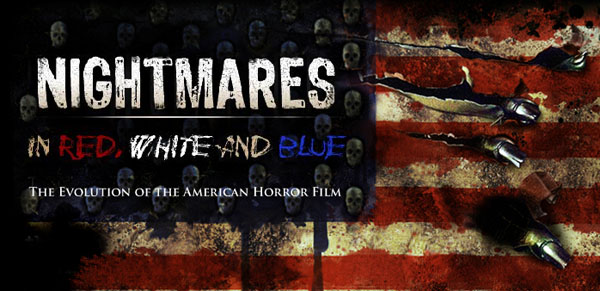| Reviews & Columns |
|
Reviews DVD TV on DVD Blu-ray 4K UHD International DVDs In Theaters Reviews by Studio Video Games Features Collector Series DVDs Easter Egg Database Interviews DVD Talk Radio Feature Articles Columns Anime Talk DVD Savant Horror DVDs The M.O.D. Squad Art House HD Talk Silent DVD
|
DVD Talk Forum |
|
|
| Resources |
|
DVD Price Search Customer Service #'s RCE Info Links |
|
Columns
|
|
|
Nightmares in Red, White and Blue: The Evolution of the American Horror Film

Nightmares in Red, White, and Blue is a relatively entertaining documentary by Andrew Monument that efficiently surveys the history of American horror films via film clips, narration by Lance Henriksen, and original interviews with film historians and some of the foremost practitioners of the genre. It is also visually clunky, and often repeats ideas originally expressed by film historian David J. Skal in his influential book The Monster Show, even though neither Skal nor his book are ever cited. This is important, because many of Skal's ideas have been broadly adopted by other film historians in the decade-and-a-half since his book was first published, and are repeated almost verbatim by the ones interviewed for this documentary. A key concept posited by Skal is the attribution of the oscillating popularity of the horror genre over the last century to various social and political problems and changes. This concept has gained traction among film writers and scholars, and it's troubling to me that Skal himself is not one of the talking heads in Monument's film, and that the whole gist of movie rests upon his ideas, sans attribution. This is not plagiarism, but one would imagine that a film taking its thesis from a pre-existing source would have drilled down to the origin of that source.
A chronological survey, Nightmares begins with Lance Henriksen intoning that the first American horror film was 1912 adaptation of Mary Shelley's Frankenstein, a film that did not earn an audience. Skipping ahead two decades, Nightmares tracks the first significant stage of American horror development with the rise of the great monster films produced at Universal Studios in the 1930s: Dracula (1931), Frankenstein (1931), The Invisible Man (1933), with The Wolf Man (1941) coming a bit later. In the 1950s, horror blended with science fiction, as fear of the atomic bomb began to pervade all aspects of American life. The morass of Vietnam begat a more graphic horror style that continued into the 1980s and has recently seen a massive revival.
Director Andrew Monument gained access to some fantastic filmmakers as interview subjects, whose insights are more engaging and grounded than those of the film historians featured here. The filmmakers include John Carpenter, Joe Dante, George A. Romero, Larry Cohen, Roger Corman, and Tom McLaughlin. Their anecdotes about the inspiration they find in the genre, and their experiences manipulating its conventions, provide some of the documentary's best material. Carpenter dissects horror as an identification of the "location of evil." Romero categorizes his series of zombie pictures as analyses of how people behave when things go wrong (i.e., fear-based reactions that lead to chaos).
Visually, Nightmares is problematic in two important ways. First of all, the documentary does not present film clips in their original aspect ratios. Older 1.37:1 footage is zoomed to fit the documentary's 1.78:1 frame, and widescreen 2.35:1 clips are cropped for the same reason. This is a distractingly bizarre choice for a documentary about the history of the movies. It tarnishes its own subject.
The other jarring visual aspect in Nightmares are multiple montages of the gruesome moments from the history of the genre. At least twice, we are subjected to extended batteries of vivisection, impaling, gouging, spurting, and decapitation. These sequences strip the clips of their original shock/horror value and amount to a blunt-force assault on viewers' senses and stomachs. They are excessive at the same time that they betray the footage in its original form.
Nightmares contains some entertainment value, and will certainly be of interest to genre fans, especially for its filmmaker interview footage. But the documentary as a whole doesn't have a particularly compelling point of view. Its reliance on the uncited work of David Skal and its discomfiting visual choices make it suspect as a genuine "tribute" to the work of others.
The DVD
Image
The enhanced 1.78:1 image is okay, but it often shows signs of video compression. The aforementioned zoomed and cropped clips are even more distracting. Not a visual masterpiece.
Sound
The stereo soundtrack is adequate.
Bonus Content
None.
Final Thoughts
Nightmares in Red, White, and Blue will interest genre buffs, but ultimately falls short as a fully-realized and well-crafted work of filmmaking. Rent it.
|
| Popular Reviews |
| Sponsored Links |
|
|
| Sponsored Links |
|
|
| Release List | Reviews | Shop | Newsletter | Forum | DVD Giveaways | Blu-Ray | Advertise |
|
Copyright 2024 DVDTalk.com All Rights Reserved. Legal Info, Privacy Policy, Terms of Use,
Manage Preferences,
Your Privacy Choices | |||||||













